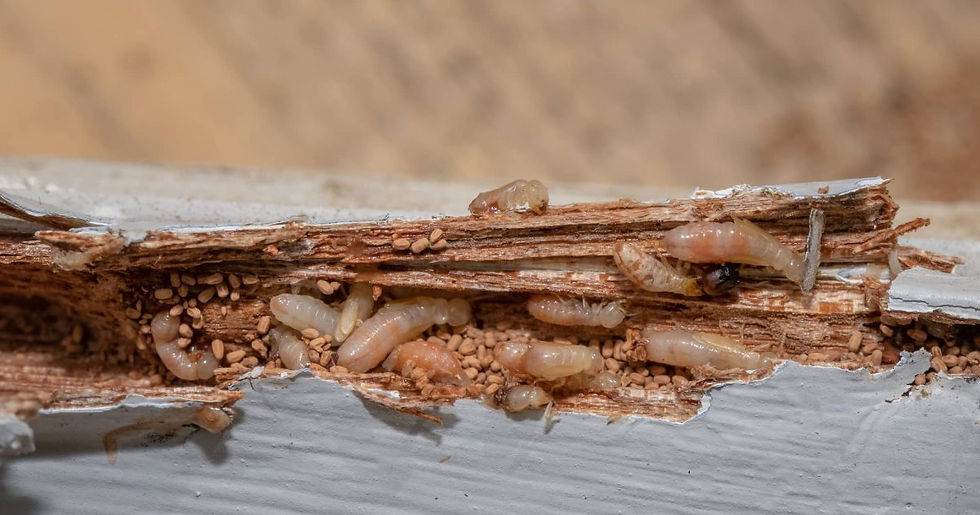The Mysterious Swarming Behavior of Termites in South Florida's Summer Heat
- swatpestsquad
- Jul 1
- 3 min read
Updated: Jul 10
Termites, often called "silent destroyers," can cause serious damage to homes in South Florida. In the hot summer months, these pests display a fascinating, yet concerning behavior—swarming. By learning about the types of termites that swarm and their habits, homeowners in South Florida can take steps to protect their properties.
Types of Termites that Swarm in Summer
Subterranean Termites
Subterranean termites are among the most common types in South Florida. These termites build colonies underground, making them hard to detect until they swarm.
Swarming occurs during the warm summer months, especially after rain when humidity is high. Winged reproductive adults emerge to establish new colonies. Homeowners often find them near lights, as they are attracted to illumination. In the U.S., subterranean termites are responsible for approximately 90% of termite damage, costing homeowners an estimated $5 billion annually.
Drywood Termites
Drywood termites present a different challenge. Unlike subterranean termites, these pests live within the wood they consume. They typically swarm in late summer to early fall. Homeowners may notice them flying out from vents or cracks in wood. An alarming statistic shows that drywood termites can lead to damages exceeding $1,000 before signs are visible. Their ability to infest wooden furniture adds to the concern since they don't need soil contact for survival.
Hybrid Termites (Formosan & Asian)
In Florida, a hybrid termite species has emerged from the interbreeding of two highly destructive, invasive termite species: the Formosan subterranean termite and the Asian subterranean termite. This hybridization, confirmed by researchers at the University of Florida's Institute of Food and Agricultural Sciences (UF/IFAS), is raising concerns about the potential for increased damage and the spread of these hybrid termites.
Formosan and Asian termites are known for being particularly aggressive in causing damage. These invasive termites, which originated in East Asia, have thrived in South Florida's humid climate.
They usually swarm at night and are most active in early summer. The rapid reproduction of Formosan & Asian termites can lead to swarms of thousands, escalating a minor issue into a major infestation quickly. Reports indicate that Formosan & Asian termites can consume wood at an alarming rate, leading to significant structural damage if not addressed quickly.
Identifying the Signs of a Termite Infestation
Swarmers and Wings
Seeing small, winged insects near your home during the summer is a clear sign of potential termite issues. Termites have straight antennae and a uniform waist, which sets them apart from flying ants, characterized by bent antennae and a pinched waist. After swarming, termites typically shed their wings, so finding discarded wings near windows, doors, or in spider webs is common.
Tunnels and Mud Tubes
Mud tubes are a signature sign of subterranean termites. These tubes are created for travel between underground colonies and food sources. Often found in dark, moist areas like crawl spaces and basements, the presence of mud tubes indicates a serious infestation that homeowners should address without delay.
Wood Damage
For drywood termites, wood damage is often the first noticeable sign. Homeowners might discover hollow-sounding wood or small piles of frass (wood-colored droppings). Damage can occur in numerous wooden structures, such as beams and furniture, making timely recognition of their presence crucial.
Prevention Tips for Homeowners
Regular Inspections
Routine inspections are vital for early detection of termites. Homeowners should be particularly vigilant during the summer swarming season. Hiring professional pest inspection services can provide peace of mind and often uncover hidden infestations.
Moisture Control
Moisture attracts termites, making control essential. Homeowners should ensure gutters and downspouts are clear and direct water away from foundations. Repairing leaks and maintaining proper drainage can significantly reduce the chances of termite attraction.
Seal Entry Points
Preventing termites from getting indoors is key. Homeowners should seal cracks and crevices in foundations, doors, and windows. Ensuring wooden structures do not have direct contact with soil also helps keep termites at bay.
The Importance of Prompt Action
When a termite infestation is confirmed, swift action is crucial. The longer termites are allowed to stay, the more damage they will cause. Engaging a professional pest control service offers effective treatment options tailored to the specific type of termites in your area.
Staying Vigilant
Termites may be small, but their summer swarming behavior in South Florida serves as a reminder for homeowners to remain alert. By understanding the types of termites, recognizing signs of infestations, and taking preventative measures, you can better protect your home. With the right knowledge and prompt action, you can keep your home safe from the impact of termites.
Staying informed and proactive allows residents of Hollywood, West Park, Hallandale, Miami, and surrounding areas to enjoy summer without the fear of unwelcome visitors damaging their homes.










Comments